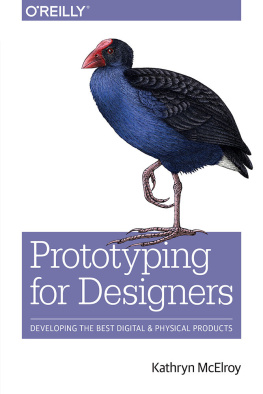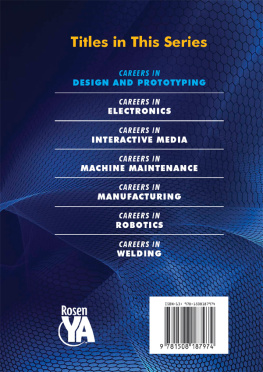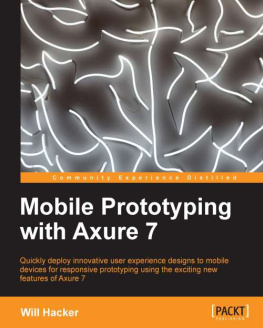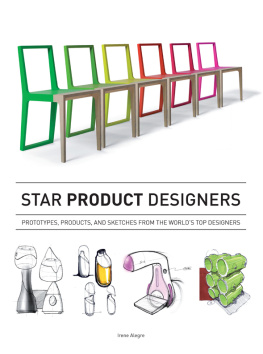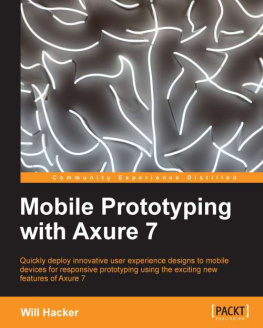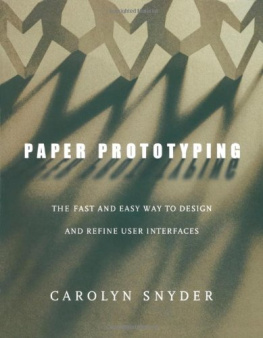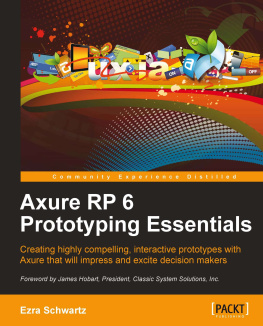Praise for Prototyping for Designers
Prototyping is one of the most important skills for designers to learn and integrate into their practice. When it comes to breaking prototyping into an actionable, teachable framework there is no one more qualified than Kathryn McElroy. This book is an important addition to every designers bookshelf.
Abby Covert, Faculty, SVA Products of Design
Prototyping is vital to all stages of product development, from discovering user needs to testing more refined ideas. This book provides an in-depth look at all aspects of the prototyping process. While its a handy reference for designers and makers, Id also recommend this book for product managers and design advocates promoting design thinking within their organizations.
Chris Milne, Product Manager at Capital One, previously Senior Designer/Prototyper at IDEO
Prototyping has become an essential way to develop products and services with a focus on the people who will use them. Kathryn McElroy has broken down the fundamentals of prototyping in a clear, accessible, and digestible way that will elevate the skills of designers and nondesigners alike.
Doug Powell, Distinguished Designer, IBM
Part of being a really great designer is more than being able to have a visionit is allowing others to see that vision and in turn, changing the way they think. This book is that vision. Kathryn allows the reader to see that prototyping is more than just a check in a checkbox but a mindset that allows you and your designs to grow and succeed. Always be prototyping.
Brent Arnold, Creative Director at Motivate (Citi Bike), Adjunct professor at SVA Products of Design
Prototyping for Designers
Developing the Best Digital and Physical Products
Kathryn McElroy
Prototyping for Designers
by Kathryn McElroy
Copyright 2017 Kathryn McElroy. All rights reserved.
Printed in the United States of America.
Published by OReilly Media, Inc., 1005 Gravenstein Highway North, Sebastopol, CA 95472.
OReilly books may be purchased for educational, business, or sales promotional use. Online editions are also available for most titles ( http://oreilly.com/safari ). For more information, contact our corporate/institutional sales department: (800) 998-9938 or corporate@oreilly.com .
Acquisitions Editor: Nicolas Lombardi Editor: Angela Rufino Production Editor: Melanie Yarbrough Copyeditor: Jasmine Kwityn Proofreader: Molly Ives Brower Indexer: Lucie Haskins | Cover Designer: Randy Comer Interior Designers: Ron Bilodeau and Monica Kamsvaag Illustrator: Rebecca Demarest Compositor: Melanie Yarbrough |
January 2017: First Edition.
Revision History for the First Edition:
2016-12-20First release
See http://oreilly.com/catalog/errata.csp?isbn=0636920049487 for release details.
The OReilly logo is registered trademarks of OReilly Media, Inc. Prototyping for Designers and related trade dress are trademarks of OReilly Media, Inc.
Many of the designations used by manufacturers and sellers to distinguish their products are claimed as trademarks. Where those designations appear in this book, and OReilly Media, Inc., was aware of a trademark claim, the designations have been printed in caps or initial caps.
Although the publisher and author have used reasonable care in preparing this book, the information it contains is distributed as is and without warranties of any kind. This book is not intended as legal or financial advice, and not all of the recommendations may be suitable for your situation. Professional legal and financial advisors should be consulted, as needed. Neither the publisher nor the author shall be liable for any costs, expenses, or damages resulting from use of or reliance on the information contained in this book.
978-1-491-95408-9
[LSI]
In loving memory of my Dad, who always told me you have exactly enough time to do the things that matter most to you. Im glad I made the time to write this book, and I wish you were here to read it.
[ Foreword ]
Truth be told , I was completely predisposed to love this book. I dont know anyone who has a more stalwart belief in the value of the prototype than I do (well, I guess it would be Kathryn McElroy at this point!), and Ive lived that devotion in both my professional design practice and in my life as an educator.
Many years ago, I was part of a boutique design consultancy in Norwalk, Connecticut, engaged to imagine the next toothbrush for a leading toothbrush manufacturer. We were happy to get the job, but it was clear that other, larger firms were similarly engaged in a kind of Phase exploration; the company was hedging their betnot a terrible strategy, and pretty common. Instead of having a lot of brainstorming meetings and talking about where we might innovate the next mouth care experience, each of the designers on our team got into the model shop. Back then, we didnt have digital fabrication tools, so everything we created was cut on band saws and table saws, spun on lathes, glued and pinned and lashed together with jerry-rigged joints and fasteners, and of course, constructed by hand. We used plastic, wood, metal, cannibalized bristles from other brushesweird mesh materials and woven fabric samplesreally, anything we could get our hands on and be creative with. And we built toothbrushes. Lots of them.
We had only a couple of weeks before the first review with the client, and when they walked into the office they were startled to find something that they were clearly not expecting: a long, long row of physical prototypesover in alllaid out in a line, with periodic glasses of disinfectant wash. And yes, we had built all of these hacked-together models, and personally tested each by actually brushing with them as we continually prototyped, iterated, and refined them (along with sanitizing them!), and we expected our clients to do the same. It was one of the most exhilarating presentations wed ever givenmoving through each prototype, sharing everything wed learned around ergonomics, function, form, fit, color, texture, you name itand the feedback could not have been more positive. We also found out that the other design firms showed the client their spinning animations of high-gloss brush handle renderings on computer screens; they hadnt made a thing. (I think you can guess who received the contract to move on to Phase .)
During the first year of the Products of Design graduate program I founded at the School of Visual Arts in New York City (and from which Kathryn was one of our inaugural graduates), I made a poster that read, No Prototype, No Meeting. That poster is still up today, and has become a kind of ethos and rallying cry of the department pedagogy. I wrote that slogan because too often I would pass by small group of students working on a project togethertalking. And talking. They were trying to think of a (brilliant) idea instead of building their way to lots of (generative) ideas. Id interrupt them and suggest that they each go make something independentlyeven for just half an hourand then reconvene and respond to what they had made. The results were startling: they always returned with a plethora of ideas, inventions, and new directions, their energy, curiosity, and enthusiasm sky-high. They were happy. And they were on their way to producing truly meaningful work.
In Prototyping for Designers , Kathryn McElroy provides a master class in the value of the prototype. But she does many things in addition. Not only does she argue for its value, but she gives us vocabulary with which to talk about and distinguish between prototypes, along with methodologies and rationales to help us employ them to their greatest potential impact.
Next page
